Over the summer we grew a test patch of Dakota Black Popcorn to see how well they’d do. We let the ears dry on the stalks until the husks had turned brown and brittle, then we harvested them and allowed them to continue curing indoors.
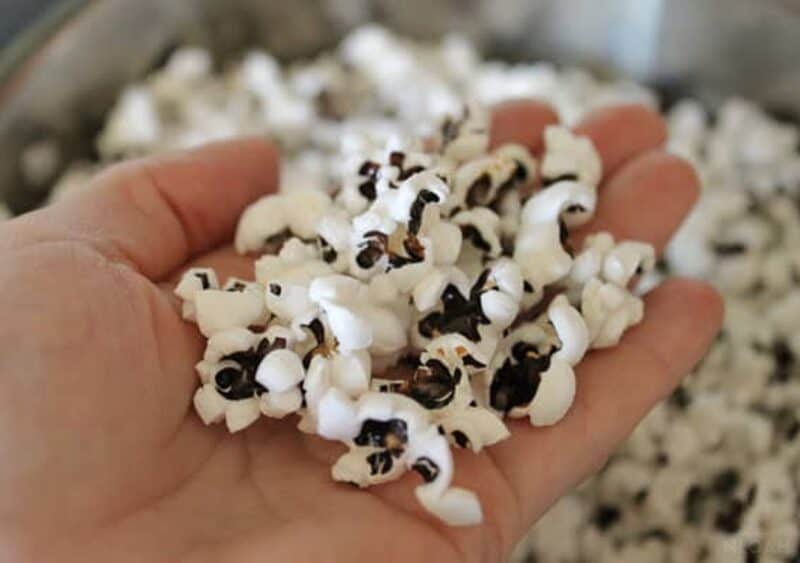
I left them in their husks placed in a basket to dry for a few months. From what I gather you’re supposed to remove their husks and hang them upside down to cure until the kernels come off easily.
There is a particular moisture content you’re seeking for best popping results. (Here’s a good article with more information on that.)

There were a couple of ears that had a little bit of fuzzy mold growing on the kernels. I think exposing them as they cure is a good idea to prevent this from happening in the future.
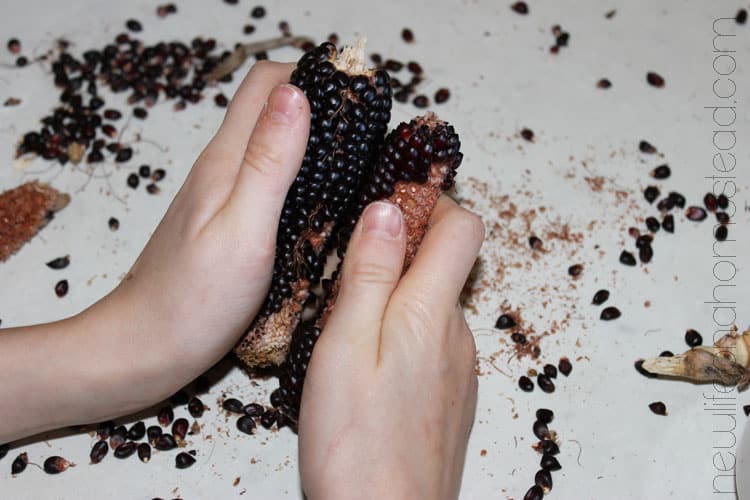
The kids have been begging to try our popcorn, so we sat down the other day and set to the task of shelling the corn. Boy did our hands take a beating! Those little pointed kernels are sharp.
It wasn’t until we were almost through the batch when we figured out that rubbing two ears together works amazingly well at removing the tough kernels, and made quick work of what remained.
We made such a mess, but the kids and I had a lot of fun. Next time we’ll shell into a paper bag or something to avoid crawling on the floor hunting down the little black beads that shot all over the kitchen.
The kids made little dolls with the remaining husks and cobs. I used the rest of the scraps as fire starter. Dried corn cobs make excellent fuel.
Homegrown popcorn is awesome because…
- you can easily grow it 100% organic
- it’s a natural, healthy snack
- it costs pennies to grow (I bought a pack of 75 seeds for $3.50; each stalk produced 1-2 ears)
- you get to add whatever seasoning you want
- no added preservatives or artificial ingredients
- if you start with an open-pollinated variety, you can save the seeds from one or two ears and have enough to plant another small patch the following year, so you’ll never have to buy more seed again
- you can grow varieties you’ll never find in a store
- it’s super fun for kids… and adults!
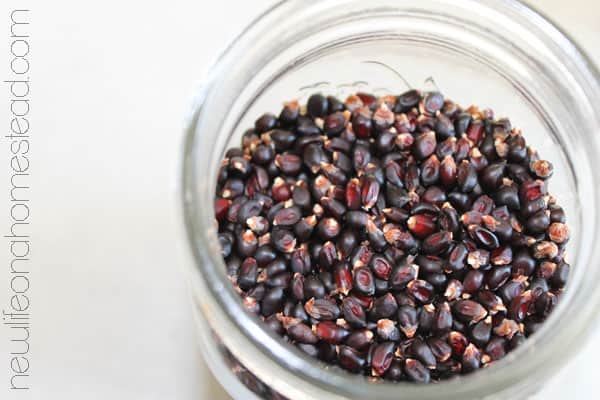
I had originally planted 30 stalks of corn. From our harvest we were able to fill a quart jar to within about two inches from the rim. The ears of this particular variety were quite small, though they filled out well.
The next test would be to see how well it would pop.
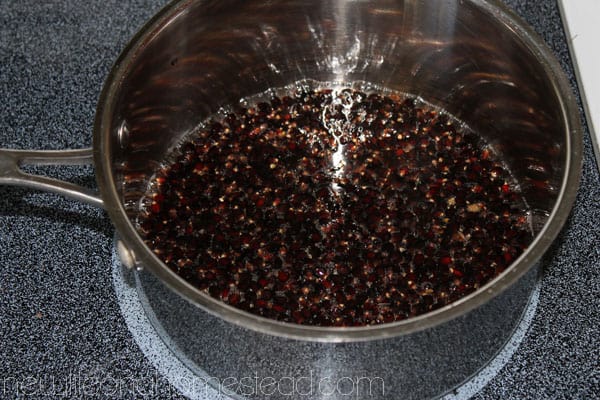
I melted 2 Tbsp of coconut oil in the bottom of a medium sized pot, then poured in enough kernels to cover the bottom, plus a little more.
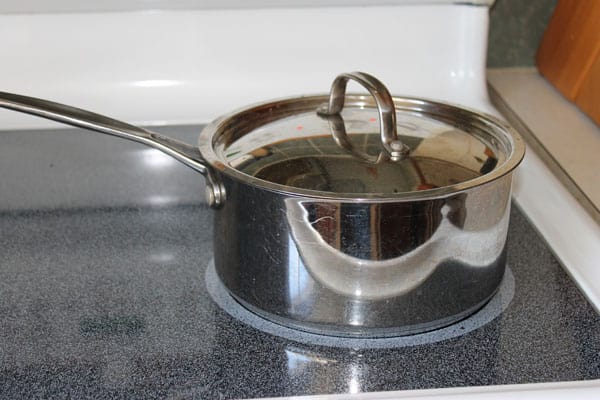
After placing the lid on the pot, I kept it at medium heat until I started to hear popping, shaking the pot back and forth by the handle every now and then.
Once the kernels started popping I turned the heat down to medium-low, continuing to shake the pot several times per minute.
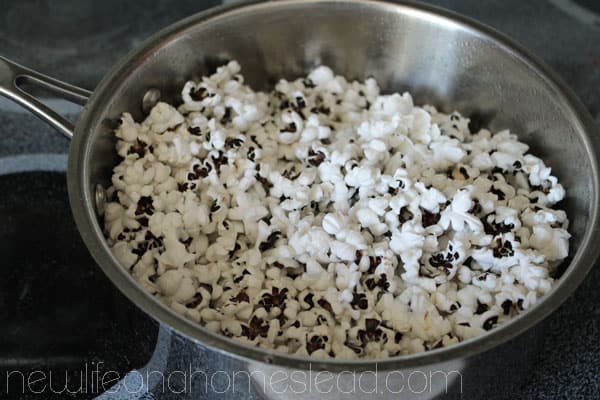
When the popping slowed I took the lid off the pot, and gave it all a stir. When the pot was full I removed it from the heat and poured the kernels into a bowl to prevent scorching on the bottom.
The kernels looked burnt, but the dark bottoms you see are what remained of the dark red kernels. They were very good without any additional flavoring, but I still drizzled them with melted butter and sprinkled lightly with salt. Perfection.
I was pleased to find that our kernels had a much better success rate of popping than store-bought kernels we’ve used in the past. There were hardly any unpopped kernels leftover in the pot.
It took about a pint of kernels (or half my jar) to provide enough popcorn for five of us to snack on. We’re going to have to plant a whole lot more than 30 stalks this year if we want more popcorn than 2 snacks worth!
Have you ever grown popcorn? What’s your favorite variety?

A city girl learning to homestead on an acre of land in the country. Wife and homeschooling mother of four. Enjoying life, and everything that has to do with self sufficient living.

I am currently drying my kernels, but some ears have mold on them. Are they still edible or should I throw them away?
Did you ever find an answer to your question. I grew and dried my own and put them in a jar with a Silica Gel Desiccant. Unfortunately, today I noticed a fuzz on my kernels. I’ve rinsed off the kernels and they look normal, but not sure we should still eat them. I’d even be willing to toss them with dish soapy water and give them a good rinse if they are still edible. I’m thinking only the outside got fuzzy, but maybe theirs mold inside? Thoughts?
We have grown the Dakota Black popcorn as well for 2 seasons. Last year’s popcorn did great drying in a paper bag. We popped it in the air popper and it we De-LISH! This year I did the same, but there must have been some moisture in the leaves because there is a bit of mold on some. I took the leaves off and will leave in a cardboard box and hope for the best, I guess, before taking the kernels off
Hi! Just ran into your site looking for popcorn tips. We grew our own this year for the first time. Everything turned out great as far as popping goes but now I’ve noticed that the popcorn we’ve stored (in air tight bags too!) has tiny moths in it! Imagine my sadness when I found out the delicious popcorn we grew and harvested with care had bugs! Anyone have any ideas on ways this can be prevented for future harvests? I’m going to assume the eggs were already in the popcorn at harvest time since they’ve been stored air tight since then. (Which leads me to believe we’ve eaten a few too, yuck!)
Bummer!! So far I haven’t had that happen to my popcorn, but any kind of grain will hatch moths or weevils over time. Even store bought stuff. You can freeze grains for 3 days to kill any eggs that might be on them to avoid further infestations.
I noticed that you suggested saving seed so that you won’t have to buy more again. Unfortunately corn is an extreme example of crops that need lots of plants to prevent inbreeding depression. It is suggested to have a minimum of 100 plants with 200+ being ideal. I have been looking into ways to save my own seed with a limited amount of land just like you. The issues of inbreeding depression, cross pollination, seed viability limitations (seeds only stay good for a certain amount of time), etc. have been making me reconsider if I should try to save my own seed at all. This website has a free, but very detailed guide to saving seed: http://www.howtosaveseeds.com . I printed it out and refer to it often, and it’s where I got most of my info. I think a combination of time isolation, growing a smaller number of varieties, and caging/hand pollination are ways I am going to address saving my own seeds since I don’t have enough land for the proper isolation distances. What are your thoughts Kendra?
Mountain Mom,
Yes, the topic of saving corn seeds could certainly fill another lengthy post. There is so much that goes into it. You are absolutely right about everything you have mentioned pertaining to saving corn seed. The methods you mentioned could work, but would be quite labor intensive. I would probably grow one variety at a time, alternating what I grew each year to avoid cross-pollination.
One way we would be able to justify planting a space of 100-200 stalks of corn on our acre of land would be to maximize the productivity of that area by using the Three Sister’s Planting Method, which we do even with smaller plots of corn. For those who don’t know, this involves planting pole beans at the base of young corn stalks so that the vines use the stalks as a climbing support, and planting squashes between the corn stalks to sprawl over the ground shading out weeds between rows. Not only does this allow for more food growth in a small space, but each of these plants helps the other to grow better by adding nutrients to the soil to replenish each other and by discouraging weeds.
Those are good ideas. This year when I bought some black bean seeds I looked specifically for a variety that was a pole type so that if I grow corn it will be maximizing the space as much as possible. Companion planting is something that I’ve researched extensively because it seems to be a wonderful way to increase productivity and reduce pests naturally while using space the most efficiently. But just to clarify, I wasn’t talking specifically about corn when I mentioned ways to avoid cross pollination. Only the most dedicated/crazy would hand pollinated corn IMO, lol. I am thinking of ways to save all of my seeds and not have to buy new ones each year like you are. Where hand pollinating wouldn’t be hard though is when a plant has large flowers (Squash, melons, etc…). Just put a cloth sachet over one male and one female per plant. Then you hand pollinate and wait until the bloom shrivels up so an insect can’t get in. If you did that just one time for each plant and marked which one you did it to it wouldn’t matter if the rest of the fruits were crossed because you weren’t saving seed from them.
We have grown our own popcorn the last few summers, and we love it. We’ve had varying degrees of success with the right moisture content and ours always seems to have more unpopped kernels than store-bought. BUT the hulls never get stuck in our teeth, and the unpopped ones are easily crunched and munched on. . . not the hard and break-your-teeth type that are left with store-bought.
We have been using Smoke Signals from Seed Savers. I don’t ever want store-bought again 🙂
That’s awesome, Jody S. Yeah, I noticed that the kernels were much easier to chew up than store-bought also. It must be the variety difference. I’d love to know how you cure your popcorn!
We basically pick it when it’s all dried out and then take the husks off. It sits in a bushel basket until we have time to take it off the cob.
As for the moisture, once we have it all in a jar, we do a test pop and add water a few drops at a time as necessary. We’ve not had it too wet yet.
Interesting, Jody S. I haven’t heard of adding water to it.
We are fortunate to have nearby the largest popcorn processing facility on the east coast. It grows, imports locally, pops, and packages almost all of the popcorn sold in stores and exported around the world. We took a tour this year, and it was really neat. Popcorn is one of the least GMO foods out there because it’s nearly perfect already! So, even though I won’t eat GMOs on purpose, it’s good to know that popcorn from the store is the food least modified.
I didn’t realize that about popcorn not likely to be GMO. Thanks, Mandie! Good to know. 🙂
This is neat, thanks for sharing about it! It’s something I’ve thought of trying when we move someday soon.
We really enjoyed our first homegrown popcorn. Totally worth it if you have the space 🙂
I usually just stick the whole cob in the microwave in a paper bag and the kernels pop right off!
Lauren,
That’s too funny! We don’t use a microwave, but that does sound like an easy way to do it.